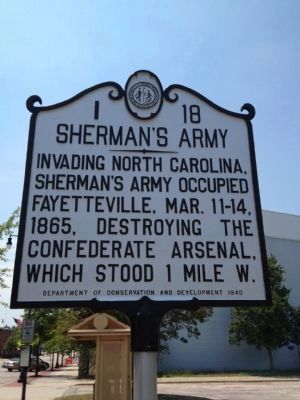Fayetteville in Cumberland County, North Carolina — The American South (South Atlantic)
Sherman's Army
Erected 1940 by Department of Conservation and Development. (Marker Number I-18.)
Topics and series. This historical marker is listed in this topic list: War, US Civil. In addition, it is included in the North Carolina Division of Archives and History series list. A significant historical year for this entry is 1865.
Location. 35° 3.25′ N, 78° 52.95′ W. Marker is in Fayetteville, North Carolina, in Cumberland County. Marker is on Hay Street, on the right when traveling west. Touch for map. Marker is in this post office area: Fayetteville NC 28301, United States of America. Touch for directions.
Other nearby markers. At least 8 other markers are within walking distance of this marker. Settlement of the Upper Cape Fear (within shouting distance of this marker); Scotch Spring (about 500 feet away, measured in a direct line); Plummer Bridge (approx. 0.2 miles away); Currahee Rocks (approx. ¼ mile away); Charter of the University of N. C. (approx. ¼ mile away); First Presbyterian Church (approx. ¼ mile away); Town House (approx. ¼ mile away); Old Town Hall (approx. ¼ mile away). Touch for a list and map of all markers in Fayetteville.
Regarding Sherman's Army. In late 1864, Union General William T. Sherman began moving his forces, some 60,000 battle-hardened soldiers strong, northward from Atlanta to “divide the Confederacy in two.” The plan was to march the Union forces through Georgia, South Carolina and North Carolina in order to squeeze Confederate forces under General Robert E. Lee in Virginia between Sherman’s men to the south and those of General Ulysses S. Grant to the north. Along the way, Sherman hoped to disrupt Confederate supply lines and break the will of southerners on the home front. This “total war” assault on civilians – women and children included – by Union forces was a break from traditional warfare that had, up until this time, focused largely on military targets.
In Georgia and South Carolina Sherman’s men freely plundered their surroundings as they marched, leaving
whole towns in ashes. As they approached North Carolina, Sherman’s forces were divided into separate divisions or corps. They traveled across the state to protect each other’s flanks, forage for supplies and to spread their influence throughout the state. The forces were more restrained in North Carolina because many had grown uncomfortable with the wholesale destruction wrought upon South Carolina. Additionally, North Carolina had been the last state to secede and was home to many Unionists who fostered the largest peace movement in the Confederacy. Union forces under Sherman entered North Carolina in early March and trekked northward through the state, engaging in skirmishes and battles, before exiting the state on May 4, 1865.
As planned, Sherman’s army moved into Fayetteville and occupied the city as he rested his troops and horses for three days beginning on March 11, 1865. Fayetteville was an intermediary goal between Sherman’s entry into the state and Goldsboro, his primary objective. The leading Union lines encountered little resistance as they entered the city. Confederate forces in the area had barely left the area before the Union arrival and were planning to mass their numbers to confront Sherman at either Goldsboro or Raleigh. Sherman set up temporary headquarters at the former United States Arsenal and directed his men to construct pontoon bridges across the Cape Fear River to speed their advance to Goldsboro. Sherman also ordered the destruction of the area’s key facilities that supported the Confederate army including railroad trestles, mills, factories and the “utter destruction” of the arsenal and its supplies. The city’s residents were also thoroughly ransacked with all supplies, money and valuables taken by Union bummers. (North Carolina Office of Archives & History)
Credits. This page was last revised on June 25, 2021. It was originally submitted on July 8, 2012, by Mike Stroud of Bluffton, South Carolina. This page has been viewed 531 times since then and 18 times this year. Photo 1. submitted on July 8, 2012, by Mike Stroud of Bluffton, South Carolina.
